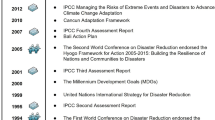Abstract
The positive role of hydropower in climate change adaption is well accepted by the international community and has been highlighted many times, while the understanding of its impacts on socioeconomic development remains at the stage of rough estimation and qualitative description. The application of a multi-regional CGE model in this paper provides an effective tool for quantitatively assessing the socioeconomic impacts of hydropower development, reflecting its positive functions. This case study on the Upper Chuan River details the steps of model development, including impact mechanism analysis, regional delimitation, macro closure setting, shock selection, and database preparation. The results show the enormous economic benefits of hydropower development using various indicators such as consumption, investment, GDP, employment, and income. The study indicates that hydropower development is a win-win energy development mode which can help to realize the integration of sustainable development and climate change mitigation. Finally, potential improvements to the model are discussed.
Similar content being viewed by others
References
Jia J S, Punys P, Ma J. Hydropower. In Handbook of Climate Change Mitigation and Adaption. Berlin: Springer, 2013
Wu J H, He C L, Xu W L. Energy footprint evaluation of hydropower projects. Sci China Tech Sci, 2013, 56: 2336–2342
Jia J S, Ma J. Roles of dams and reservoirs in a changing world. India Power, 2010, 10–12: 22–25
Jia J S, Xu Y, Ma J, et al. Discussion on hydropower return, its relationship with socio-economic development and new concept for development. J Hydroelec Eng, 2012, 31: 1–5
Xu W, Peng Y, Wang B. Evaluation of optimization operation models for cascaded hydropower reservoirs to utilize medium range forecasting inflow. Sci China Tech Sci, 2013, 56: 2540–2552
National Energy Administration, DL/T54410. Specification on Economic Evaluation of Hydropower Projects. Beijing: China Electric Power Press, 2010
Nordgard D E, Heggset J, Daleng J. Using risk analyses in a multi criteria decision making framework for evaluation of hydropower maintenance projects. Power Tech, 2005 IEEE Russia. IEEE, 2005: 1–7
De Almeida A T, Moura P S, Marques A S. Multi-impact evaluation of new medium and large hydropower plants in Portugal centre region. Renewable Sustainable Energy Rev, 2005, 9: 149–167
Wang L Y, Guo L, Huang L. Analysis on pulling effect for hydropower construction to regional employment. In: 2010 International Conference on Management and Service Science, Wuhan, 2010. 1–5
Ding Y, Tang D, Wang T. Benefit evaluation on energy saving and emission reduction of national small hydropower ecological protection project. Eng Procedia, 2011, 5: 540–544
Lin B Q, Mou D G. The impact of energy price increase on marco-economy: An analysis based on CGE model. Econ Res J, 2008, 11: 88–101
Gao Y, Li S T. Analysis on the influence of energy tax on society, economy, energy and environment. China Pop Res Environ, 2009, 19: 30–35
Wei W X. An analysis of China’s energy and environmental policies Based on CGE model. Stat Res, 2009, 26: 3–12
Yang L, Mao X Q, Liu Q. Impact assessment for energy taxation policy based on a computable equilibrium (CGE) model. China Pop Res Environ, 2009, 19: 24–29
Wang L X, Zou Y F, Wei X P. Evaluating on energy use security of China based on the CGE and EFA. China Ind Econ, 2009, 04: 85–93
Bi Q H, Fan Y, Cai S H, et al. Analysis of China’s primary energy demand scenarios based on the CDECGE model. China Pop Res Environ, 2013, 23: 41–48
Fan X, Ma S C, Zhu L Z. A simulation analysis of Chinese reduction policies based on CGE Model. Ecol Econ, 2013, 09: 50–54
Shi M J, Yuan Y N, Zhou S L, et al. Carbon tax, cap-and-trade or mixed policy: Which is better for carbon mitigation? J Man Sci China, 2013, 09: 9–19
Wang L J, Zhao Y, Wang Z. The impact of CGE-based carbon tax on China’s economy. Ecol Econ, 2014, 04: 29–32
Wu D. Study on the impact of the resource tax reform on the coal industry based on the CGE Model. Contemp Econ Man, 2014, 07: 62–65
Wittwer G. An outline of TERM and modifications to include water usage in the Murray-Darling Basin. Draft report prepared for the Productivity Commission, the Department of Treasury and Finance, Victoria, the Department of Primary Industries, Victoria, and the CSIRO. http://www.monash.edu.au/policy/archivep.htm. 2003
Wittwer G. Economic Model of Water Australia CGE Experience. Berlin: Springer, 2012
Horridge J M, Wittwer G. The economic impacts of a construction project, using SinoTERM, a multi-regional CGE model of China, China Econ Rev, 2008, 19: 628–634
Liu Y, Cai S F, Wang Y, et al. Comparative analysis of the separate carbon market and inter-provincial carbon market-based on Chinese multi-regional CGE Model-TermCo2. Financ Trade Econ, 2013, 11: 117–127
National Bureau of Statistics. China Statistical Yearbook-2012. Beijing: China Statistics Press, 2012
Dixon P B, Parmenter B R, Sutton J M, et al. ORANI: A Multispectral Model of the Australian Economy. Amsterdam: North-Holland, Hereafter DPSV, 1982
Dong C Z. Input-output Analysis. Beijing: China Financial & Economical Publishing House, 2000
McDougall R. Entropy Theory and RAS are Friends, GTAP Working Paper No. 06. GTAP. 1999
Cai F. Demographic transition, demographic dividend, and Lewis turning point in China. China Econ J, 2010, 3: 107–119
Zhang X, Yang J, Wang S. China has reached the Lewis turning point. China Econ Rev, 2011, 22: 542–554
Author information
Authors and Affiliations
Corresponding author
Rights and permissions
About this article
Cite this article
Liu, Y., Ma, J., Wang, H. et al. Multi-dimensional assessment of socioeconomic impacts of hydropower development—A case in the Upper Chuan River. Sci. China Technol. Sci. 58, 1272–1279 (2015). https://doi.org/10.1007/s11431-015-5844-x
Received:
Accepted:
Published:
Issue Date:
DOI: https://doi.org/10.1007/s11431-015-5844-x




